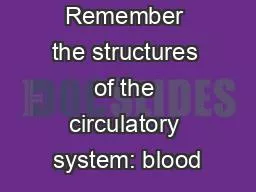

Hematology Essential questions What are the structures of blood What is hematology 201 Remember the structures of the circulatory system Blood Hemat blood ology the study of ID: 779644
Download The PPT/PDF document "2.01 Remember the structures of the circ..." is the property of its rightful owner. Permission is granted to download and print the materials on this web site for personal, non-commercial use only, and to display it on your personal computer provided you do not modify the materials and that you retain all copyright notices contained in the materials. By downloading content from our website, you accept the terms of this agreement.
Slide1
2.01 Remember the structures of the circulatory system: blood
Hematology
Slide2Essential questions
What are the structures of blood?
What is hematology?
2.01 Remember the structures of the circulatory system
‹#›
Slide3Blood
Hemat- = blood
-ology = the study of
The average adult has 8 – 10 pints.
2.01 Remember the structures of the circulatory system
‹#›
Slide4Blood
One drop of blood contains:
5 million RBCs250,000-500,000 platelets
7,500 WBCsRed blood cells live 120 days.
New blood cells created 2 million per second!
2.01 Remember the structures of the circulatory system
‹#›
Slide5Structures (Components) of the blood
Plasma
Erythrocytes
LeukocytesThrombocytes
2.01 Remember the structures of the circulatory system
‹#›
Slide6Plasma
Liquid portion without cellular components
Straw-colored liquid
55% of the blood’s volumeWater
Plasma proteinsNutrients
Electrolytes
Hormones, vitamins, and enzymes
Waste products
2.01 Remeber the structures of the circulatory system
‹#›
Plasma
Cellular elements
Slide7Plasma proteins
Fibrinogen
AlbuminGlobulin
Gamma globulinProthrombin
2.01 Remember the structures of the circulatory system
‹#›
Plasma
Cellular elements
Slide8Plasma proteins
Fibrinogen
Helps with blood clottingMade in liver
AlbuminHelps blood to coagulate
Needs vitamin K for prothrombin synthesisGlobuli
n
Gamma Globulin
Prothrombin
- helps blood to coagulate, needs vitamin K for prothrombin synthesis
‹#›
Plasma
Cellular elements
Slide9Erythrocytes
Biconcave disk
HemoglobinHemo (blood)Globin (protein)
Blood protein that gives the cells its red colorTransportation
Oxygen to cellsCarbon dioxide away from cells
2.01 Remember the structures of the circulatory system
‹#›
Slide10Leukocytes (WBC)
Fight Infection
Larger than erythrocytesLeuk/o/cytes – white cellsFive types
NeutrophilMonocyteLymphocyteEosinophil
basophil
2.01 Remember the structures of the circulatory system
‹#›
Slide11Leukocytes
Agranulocytes
(without granules)Lymphocytes Monocytes
2.01 Remember the structures of the circulatory system
‹#›
Slide12Leukocytes
Granulocytes
With granulesNeutrophilsEosinophils
Basophils
2.01 Remember the structures of the circulatory system
‹#›
Slide13Thrombocytes
Smallest of solid components of blood
Synthesized in red marrow
Not cells, composed of fragments of megakaryocytesNecessary for the initiation of the blood clotting process
2.01 Remember the structures of the circulatory system
‹#›
Slide142.01
‹#›
Life span of blood cells...
Slide15Blood types
Inherited from parents
Determined by presence or absence of an antigen on the surface of the red blood cell
2.01 Remember the structures of the circulatory system
‹#›
What are the types of blood?
Slide16In 1901, the Austrian immunologist Karl Landsteiner discovered that blood may be grouped into four main types.
Based on the reaction that resulted when blood from different individuals were mixed.2.01 Remember the structures of the circulatory system
‹#›
Check your knowledge of medical history...
Slide17Blood types
Blood from the donor to the recipient must be compatible
The problem occurs when the protein (antigen) outer layer of RBC of a donor becomes coagulated or agglutinated (clumped) with the plasma proteins (agglutinins or antibodies ) of the recipient2.01 Remember the structures of the circulatory system
‹#›
Slide18Blood types
There are four different types of blood
ABABOThey are determined by the protein (antigen) found on the RBC
2.01 Remember the structures of the circulatory system
‹#›
Slide19Blood types
T
ype A RBC’s have A antigen with
B antibodiesType
B RBC’s have B antigen
with
A antibodies
Type A
B RBC’s have AB antigen with
no
antibodies
T
ype
O
RBC
’s have
(zero) a
ntigen
with
A
and
B
antibodies
AB is universal
recipient
O is universal donor
2.01 Remember the structures of the circulatory system
‹#›
Slide20Blood types
AB is universal recipient:
Universal recipient since it does not have agglutinins (antibodies) in the plasmaO is universal donorUniversal donor since it does not have antigens (proteins) on the surface of the RBC’s
2.01 Remember the structures of the circulatory system
‹#›
Slide21Rh factor
Rhesus (Rh) factor is an inherited trait that refers to a specific protein found on the surface of red blood cells (antigen).
Blood used in transfusions must match donors for Rh status as well as for ABO blood type.
Although Rh factor doesn't affect the patient’s health, it can affect pregnancy.
2.01 Remember the structures of the circulatory system
‹#›
Slide22Rh factor
In 1940, the Rh factor was discovered as a result of studying Rhesus monkeys.
When blood from monkeys was injected into rabbits and guinea pigs, it clotted.
2.01 Remember the structures of the circulatory system
‹#›
Slide23Rh factor
If the blood has the protein, the patient is
Rh positive.
If the blood lacks the protein, the patient is Rh negative.
2.01 Remember the structures of the circulatory system
‹#›
Did you know???
Slide24What is blood:
https://www.youtube.com/watch?v=JRnaSfdjdl0
2.01 Remember the structures of the circulatory system
‹#›